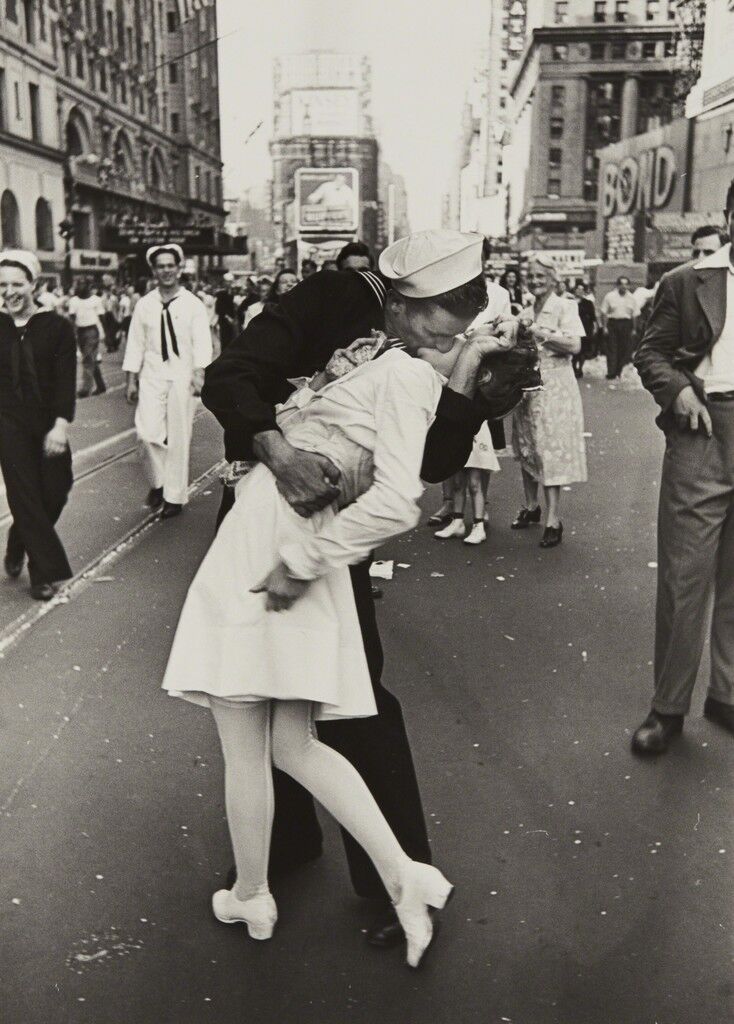Alfred Eisenstaedt was a German-born American photographer. His works were typically portrait pieces for Life Magazine in the U.S., but some of his most popular works were during and at the end of the WW2, specifically on V-J Day, when Japan surrendered, bringing WW2 to an end and the streets of America celebrated. Eisenstaedt would capture couples in their most intimate moments, of celebration and misery, where couples said their potentially final goodbyes and couples celebrating surviving the war. I have found this photographer for the inspiration of location portraiture.
Photo One

The photograph from Eisenstaedt that reached an iconic status, depicting this photo as a symbol of romance and love, known as the ‘V-J Day Kiss’. The sailor in black is captured as he embraces the nurse in white, arching her back and locking their lips in tightly; their faces forever concealed by a beautiful kiss. The two were in face perfect strangers and the sailor was on the streets celebrating by kissing many women. The silhouette of the two together presents a passion. The sailor’s hand is tightly gripped onto the nurse’s waist, pulling her in close, the other hand wrapped around the woman’s head to keep her even closer. The grip and pressure that is pulled into these two is pure and symbolises a powerful romance. The sailor’s face is pressed firmly into the nurse’s, you can see the curvature on the woman’s cheek where the sailor is pushed so firmly onto her lips that it is distorting her face. The way the nurse is held and the positioning of her legs, where one is slightly lifted up, and how her arm is fallen to her side, has her presented as delicate and is the prime symbol of femininity. Whereas the strong grip on the sailor’s hand and how he is towered over the nurse presents a symbol of masculinity. In the 1900s this was a prime representation of love between a man and a woman, and still to this day many consider this to be an example of love perfectly. The contrast in colour where the sailor is in black and the nurse in white conveys a message that suggests they may have different backgrounds and be different people, but at the end of the day, these two can still have such a passionate moment.
Photo Two


Photo Three

This is a film photo of two people, a man, and a woman kissing in the Times Squares streets during V-J Day. The photo is in portrait format and presents a large amount of the two's surroundings. Due to the lack of closeness between the two compared to the other couples, we could infer that these are just mere strangers celebrating V-J Day; their bodies aren't pressed close together and the woman's body language appears too stiff for this man to be her partner. Granted, the joy is still there between the two, the man has a strong hold onto the woman's head suggesting passion running through him, and you can detect a joy within his facial expression as he kisses this woman. Their surroundings present an open and free feeling, due to the leading lines to clear sky behind them from the buildings and the open road behind them also, where people are scattered around. The centring of the two, while their surroundings are scattered with people and confetti, creates a symbol of celebration, and due to them kissing, the logical inference is the celebration of love and peace.
Photo Four

This shot from Eisenstaedt presents a man and a woman locked into a kiss at appears to be a station of some sort. The atmosphere appears quiet and forlorn, suggested by their serious expressions as they kiss each other. Furthermore, the large windows behind and above the two's heads create a formal and restricted sense in location, compared to the V-J Day photos, there is a lack of freedom in their location. The brick walls and people surrounding them suggests they are in a station, and due to the context when Eisenstaedt was photographing, we can infer that these two are saying goodbye before the man goes off to war; similar to the second photo in this blog. Eisenstaedt had used a film camera due to the times, no flash being necessary because as we can see, the natural light has covered the whole photo and revealed the two in a delicate presentation. The composition Eisenstaedt has captured this appears as though he has taken this photo in secret. This is inferred from how close two people are to the left side of the camera and the low-level pointing up to the two kissing, as though Eisenstaedt was trying to hide the fact he was taking the photo, this also creates a candid photo. The grip in the man's hand on the woman's arm suggests passion and desperation to not leave her and stay close to her. Their bodies are pressed closely together as they kiss, conveying a need to feel each other for as long as possible before it is too late and they have to separate.
Overall…
I feel Eisenstaedt's work has taught me how a location can change a story and message of a photo. The photos above if the location was changed to a simple studio setting, the passion, and forlorn symbols would no longer exist, and you wouldn't understand the lovers' stories. The use of location, like many other factors in a photo is very important when it comes to considering the message you want to send. Eisenstaedt has inspired me to experiment with the use of location in my future shoots so I can better vary the composition styles I will use in my final portfolio, so I can reveal all the aspects of a romance between my partner and I.
No comments:
Post a Comment